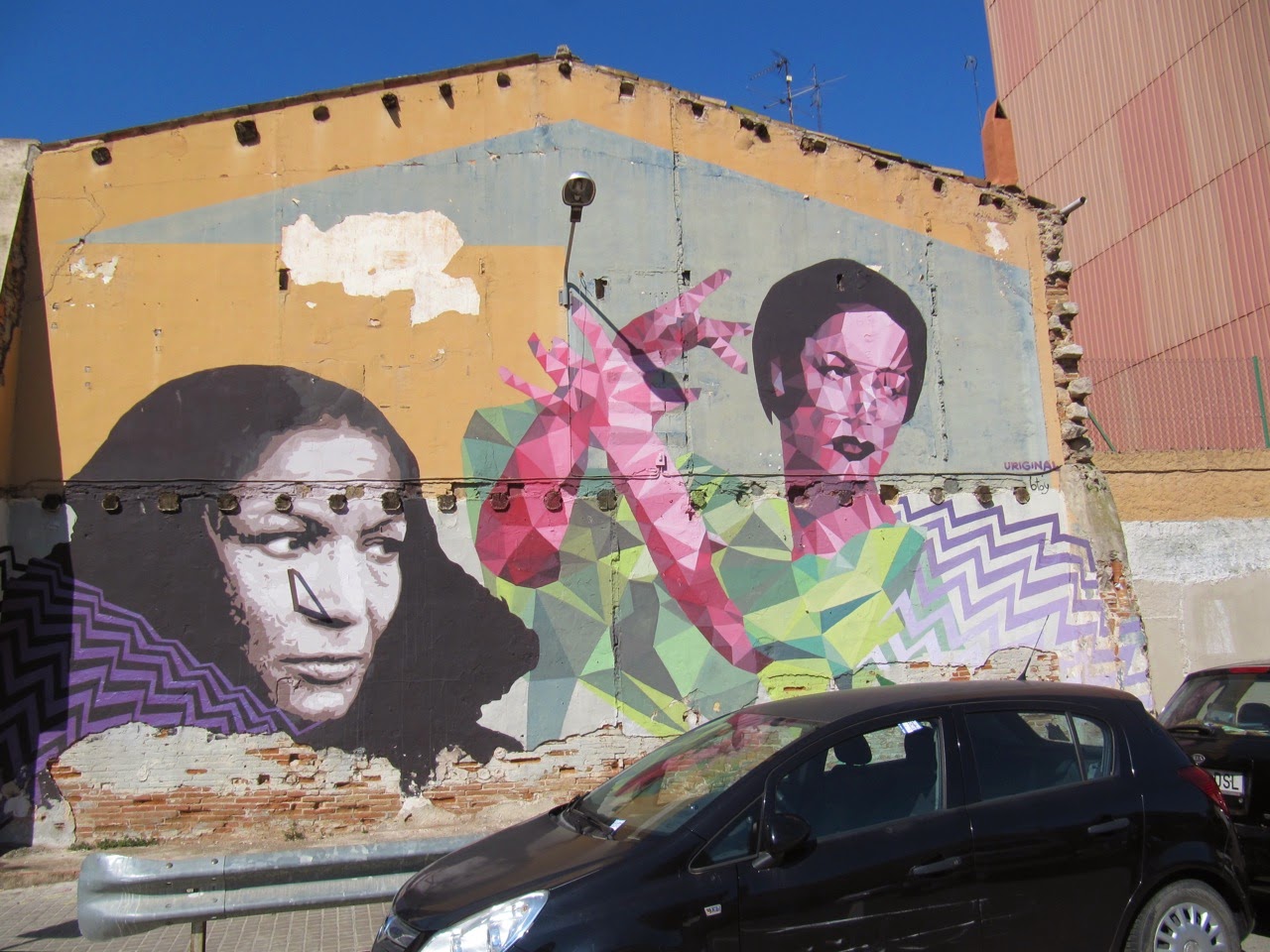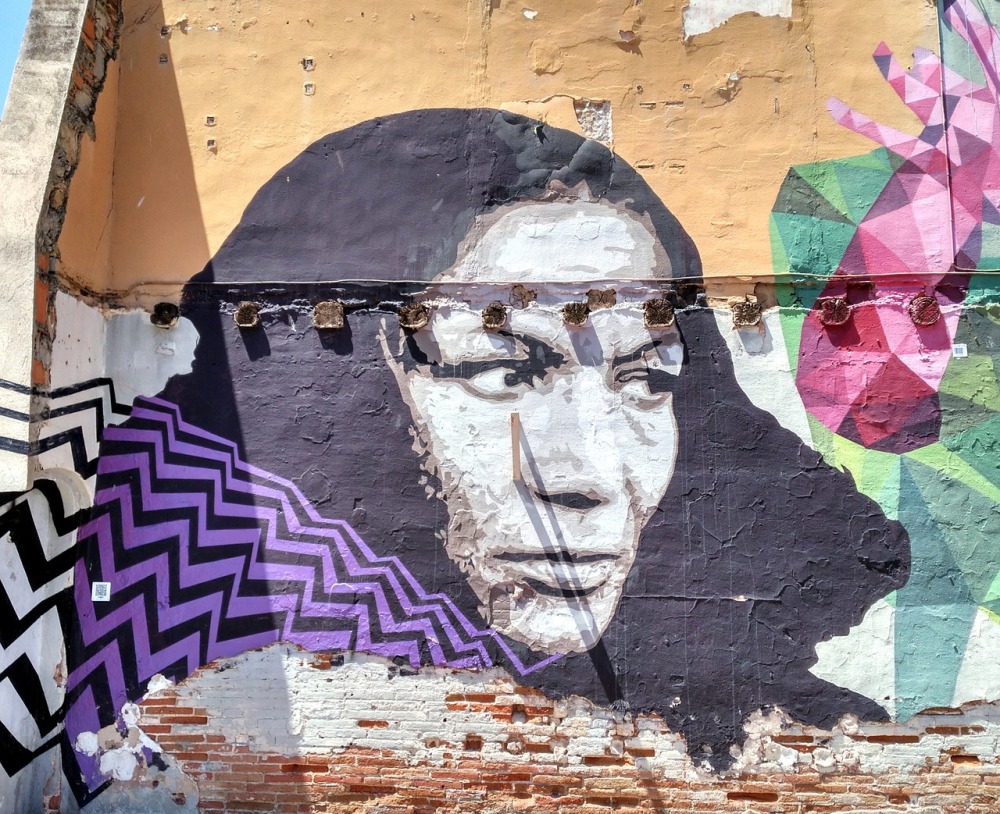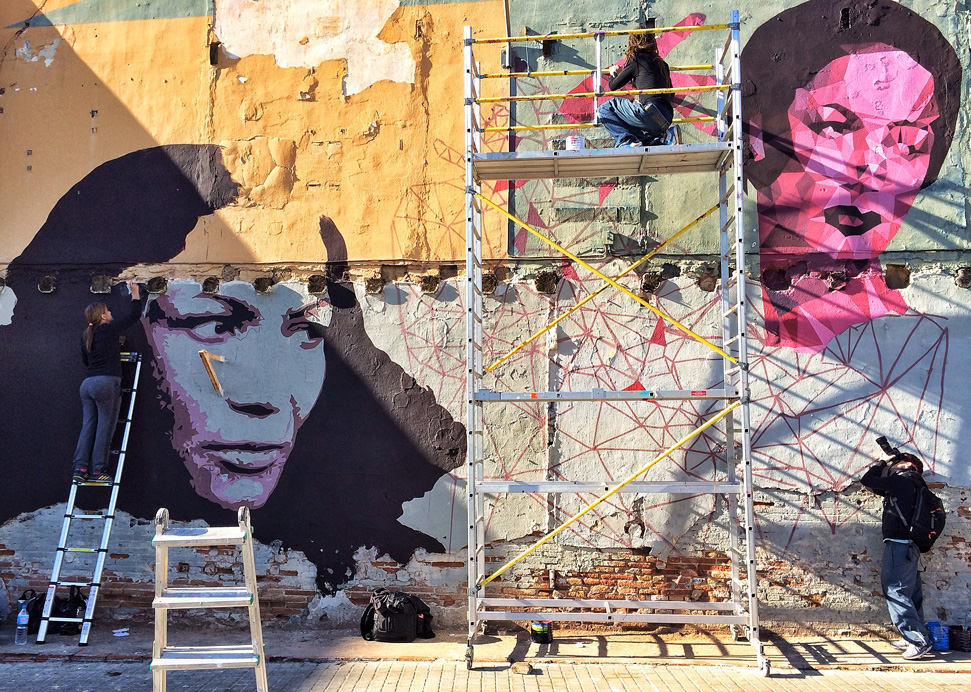Illegal much? Well, isn’t everything interesting? Like, flamenco. Or graffiti painting. Or even better…both

© Hannet Engel. This is an adaptation of an article published in Mundo Flamenco nr.40, 2017.
All you need to bring Carmen Amaya back to life are the instruments of a street artist: spray paint and brushes. Whoooshh. There she manifests! This large scale mural adorns the streets of Barcelona demonstrating that flamenco can be expressed in all sorts of ways.
BTOY and URIGINAL are graffiti names for the street artists who made flamenco dancer Carmen Amaya dance again in the streets of her own hometown Barcelona.
Celebrating Carmen Amaya
The ‘Queen of the Gipsies’, Carmen Amaya, was born in the slums of Barcelona back in 1918 changed flamenco dancing forever by When she passed away in 1963 she had left a legacy of changing flamenco dancing forever by turning flamenco’s percussive footwork into an olympic effort of technicality and speed.
Her glamourous, exotic and fierce appearance made a unique combination that allowed her to star in Hollywood movies and introduce flamenco to a broad and international audience.
In vibrant colours and on an impressive scale both Spanish artists have painted a portrait of Carmen in their own style (BTOY on the left and URIGINAL on the right) based on photographs of Carmen from the sixties.
Calle Escoles in Barcelona is the scene of the crime. That is to say, this graffiti mural was actually legal and was applied on an outside wall as part of the street art project ‘Openwalls Showcase’ in 2013. That year was declared ‘Carmen Amaya year’ because it had been fifty years since her death in 1963.
BTOY and URIGINAL explain in an interview with Kaliú Flamenco why they chose to depict Carmen Amaya; according to these street artists she hasn’t been appreciated and commemorated enough in Barcelona.

Flamenco on drugs
URIGINAL (Uri Martinez) based the portrait of Carmen Amaya on a photograph of her by Manel Gausa for the magazine Distinción in 1959 that was made during a performance in the Palau de la Música in Barcelona. Click here to see the photograph (copyright unknown).
URIGINAL himself is from Barcelona, which is a city with a flamenco tradition, but not one as rich as the flamenco history of Southern Spain. He has depicted other flamenco icons besides Carmen Amaya as well, such as guitar player Paco de Lucía and singer Camarón de la Isla.
But where did URIGINAL get his inspiration from? FlamencoArtworks© asked him
URIGINAL:
These artists formed a paradigm that you just can’t ignore. I was probably influenced by my family. They are from Extremadura and I have some cousins living in Andalusia [- which are both provinces of Spain with a rich flamenco tradition]. Flamenco is something that you are born with and that surrounds you without choosing it.
Flamenco singer Chico Ocaña often visits me in my studio [- Chico is known as lead singer of experimental flamenco band Mártires del Compás]. And so does singer and guitarist José Amaya, who is Carmen Amaya’s second cousin. He recorded a song with Paco de Lucía called Chica Bonita in 1977. In my studio I listen to Lole y Manuel a lot, but I also like psychedelic trance. As long as it tears me up and gets under my skin.
How did you get this far as a street artist?
URIGINAL [joking]:
Along the years… and with drugs.
So it seems that ’psychedelic flamenco’ would be a fitting description of URIGINAL’s artistic style of vibrant colours and hypnotising geometrical patterns. He shows us the glamorous side of Carmen Amaya’s life as a dancing star with her hands crossed in an elegant flamenco pose.
Carmen Amaya by BTOY
Barcelona-based street artist Btoy (Andrea Michaelsson) has blown up a different kind of photograph than that of URIGINAL for her graffiti mural. She depicts Carmen with her hair down and with a contemplating gaze off into the distance.
BTOY explains in an interview with Artsmania that she uses iconic photographs of famous women, mostly hollywood actresses from silent films. By depicting them she pays tribute to these women who did away with stereotypes, such as Katharine Hepburn or flappers like Clara Bow.
BTOY used a photo by photographer Colita, who shot pictures of Carmen during her last movie Los Tarantos in 1962. Click here to see the photo (copyright unknown). URIGINAL depicts the glamorous side of Carmen Amaya as an Hollywood icon, while BTOY shows the raw side of her life.
In the photo Carmen looks worn out. It turned out she died the following year from failure of the kidneys. This was probably due to the physical exertion that her style of dancing demanded of her. Although Carmen Amaya herself liked to believe that it was the other way around, that she had to keep on dancing to stay healthy and said: “If I have to stop dancing, it is better that I die.” (cited in: Francisco Hidalgo, 1995)

Flamenco and graffiti: legal or underground?
The worlds of flamenco and street art are very much comparable. In Spain street art is mostly practised illegally, comparable to the way the gipsies have always practised their flamenco secretly during times of repression. Under general Franco’s regime flamenco was even a way of inconspicuous resistance against authorities.
At the same time flamenco that is officially acknowledged as a performing art has always existed alongside the illegal flamenco activities as well. Just as nowadays there are accepted forms of graffiti like this artwork of Carmen Amaya by BTOY and URIGINAL.

Don’t forget to hit the Follow button below to receive Flamenco Artworks© posts in your e-mail!
Also check out Flamenco Artworks on Facebook.
*Carmen Amaya’s date of birth is still debated. Authors of the latest biography on Carmen suggest it was in 1917 or 1918. See: Montse Madridejos and David Pérez Merinero (2013). Carmen Amaya. Barcelona: Edicions Bellaterra
References
- https://uriginal.com
- Openwalls showcase project 2013 [ES]
- Itinerario Carmen Amaya por Barcelona historiasdeflamenco.com [ES]
- Interview with BTOY in Artsmania [ENG]
- http://www.streetartbio.com/btoy [ENG]
- Instagram Fernando Alcalá Losa
- Interview with BtoY and Uriginal on Kaliúflamenco [ES]
- Article on Carmen Amaya [ENG]
- Hannet Engel, Carmen Amaya is hot, in: Mundo Flamenco nr.27, 2014.
Books
- José Luis Navarro García, Historia del Baile Flamenco Volumen II, 2008-09
- Francisco Hidalgo Gómez, Carmen Amaya: La biografía, Barcelona 1995, edition Google books 2014
Discover more from FLAMENCO ARTWORKS © |||///|||///||| HANNET ENGEL
Subscribe to get the latest posts to your email.


Wow! En kijken sindsdien alle flamenco danseressen zo getroubeerd en geïrriteerd? 😉
LikeLiked by 1 person
Haha, ja precies, ik denk wel dat Carmen een trend heeft gezet.
LikeLike